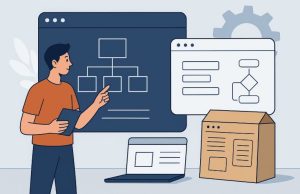
How can developers build software solutions when user expectations are still unclear? How do you align a client’s vision with an actual product early in the development process? These are the kinds of questions the prototype model in software engineering seeks to answer.
The prototype model is an essential method within the Software Development Life Cycle (SDLC), especially in cases where the project’s complete requirements are not yet defined.
It enables both developers and users to interact with a preliminary version of the product. This allows for exploration, validation, and correction before committing to final implementation.
Through its iterative and user-focused nature, the prototype model is an invaluable approach for creating intuitive, effective, and reliable software that genuinely meets user needs.
What is the Prototyping Model in Software Engineering?

In simple terms, the prototype model is a software development methodology where a working model or “prototype” of the application is first created. This prototype may not have full functionality, but it demonstrates key aspects of the software that are crucial for decision-making and feedback collection.
Unlike traditional linear development methods, such as the Waterfall model, the prototype model relies on early and active user participation. By offering a partially functional system during the early stages of development, it helps developers and users identify design flaws, missing requirements, and usability issues. This model is particularly effective for complex projects with changing needs or those involving unfamiliar technologies.
The prototype itself can vary in fidelity, from simple paper sketches or mock-ups to interactive digital simulations. These evolving prototypes bridge the gap between abstract ideas and working systems, guiding the development team toward an accurate final product.
How Does the Prototype Model Work?
The prototype model operates in a cyclical pattern of feedback and refinement. Instead of progressing in a straight line, it loops through repeated development and revision stages until the desired outcome is achieved.
The process typically begins with requirements gathering. Unlike conventional models that require exhaustive documentation at the start, this model embraces vague or incomplete inputs. Developers gather whatever details are currently available through stakeholder interviews, brainstorming sessions, or observational studies.
Next comes the quick design phase. Here, a simplified version of the system is sketched or designed to reflect the basic structure and interface. The emphasis is on speed and visualisation rather than depth or accuracy.
Following the design phase, a working prototype is constructed. This model embodies limited functionalities, but enough to simulate interaction and flow. It gives users a sense of how the system might perform in reality.
Users then evaluate the prototype, providing feedback on what works and what doesn’t. Their insights lead to refinements, correcting features, enhancing user interfaces, or even redefining the software scope. This loop continues until stakeholders are satisfied.
Once the prototype aligns with expectations, the development team proceeds to build the full version of the software. This version incorporates complete features, technical depth, and robust performance, adhering closely to the final prototype’s blueprint.
Routine maintenance follows the final deployment, ensuring system stability and long-term efficiency.
What Are the Different Types of Prototype Models?

Depending on the project goals, team dynamics, and client requirements, several variations of prototyping can be implemented.
Rapid Throwaway Prototyping
This method is built on speed. A rough prototype is created based on initial concepts and discarded after user feedback is gathered. The prototype’s purpose is solely to refine understanding of requirements rather than serve as a foundation for the final system.
It’s especially useful in the early stages when there are multiple ideas to test quickly. Since each version is built afresh, the team avoids the risk of poor design choices carrying over to the final product.
Evolutionary Prototyping
This approach treats the prototype as an evolving product. It is developed incrementally, absorbing user feedback with each iteration until the prototype matures into the final system.
Because the prototype is not discarded, this method is more efficient for long-term projects with shifting requirements. It saves time and effort, particularly in systems where user feedback is crucial for ongoing development.
Incremental Prototyping
In this model, the final product is broken down into manageable modules. Each module is prototyped individually and later integrated into a cohesive system. The primary advantage is reduced complexity, as smaller segments are easier to design, test, and refine.
However, this approach demands careful planning. If the individual pieces are not designed with integration in mind, they may not fit together as expected in the final stage.
Extreme Prototyping
Tailored for web development, extreme prototyping is a three-step approach. First, static HTML pages representing the front-end are developed. Then a simulation of data interactions is created, usually with mock services. Finally, real services are connected to the interface.
It provides a fast and reliable mechanism for developing web applications while maintaining alignment with end-user expectations throughout the process.
What Makes Prototyping Essential in Software Development?
Developing modern software is a complex process, often involving multiple stakeholders, evolving requirements, and tight deadlines. In such scenarios, prototyping plays a critical role in ensuring that the final product is not only functional but also relevant and user-friendly.
When building a software system, even the most straightforward screens or functions can be interpreted in many ways. Designers and developers face questions like: How many actions should a user take to complete a task? What should the screen layout look like? How will the system respond to different user inputs?
Prototypes help answer these questions long before coding begins. They simulate the user journey, making it easier to validate decisions, test workflows, and spot usability flaws. This reduces the likelihood of rework, budget overruns, and user dissatisfaction.
The key advantage of prototyping is that it enables teams to build the right thing, not just build it right.
How Does the Prototype Model Compare to Other Models?

To better understand the relevance of the prototype model, it helps to compare it with other popular software development methodologies:
| Feature | Prototype Model | Waterfall Model | Agile Model |
| Approach | Iterative | Sequential | Iterative and incremental |
| Flexibility in Requirements | High | Low | Very High |
| User Involvement | Continuous | Minimal | Active |
| Risk Management | Early Detection | Late Stage | Ongoing |
| Cost Implications | Moderate to High | Low | Variable |
| Ideal Use Cases | UI-heavy, unclear scope | Well-defined requirements | Rapid change environments |
The prototype model stands out in projects requiring early user interaction, visual verification, and scope exploration.
What Are the Advantages of the Prototype Model?
The benefits of the prototype model extend far beyond visual mock-ups. At its core, it is a risk-reduction strategy that enhances clarity, communication, and alignment.
Clients benefit from early visibility into the system. Developers can test assumptions and avoid costly mistakes. Stakeholders gain confidence through transparent collaboration.
Additionally, prototypes are reusable. The assets, layouts, and workflows designed during early stages can serve as reference points for future projects or become part of a larger product roadmap.
Perhaps most importantly, prototyping enhances team coordination. By offering a shared vision of the product, it unifies designers, developers, managers, and users under a common understanding.
What Are the Limitations of the Prototype Model?

Despite its strengths, the prototype model is not without drawbacks. The iterative nature can lead to increased time and cost, particularly when feedback loops extend longer than expected.
Clients may become overly fixated on the prototype and prematurely demand a production-ready version. Developers, under pressure to deliver quick iterations, might adopt inefficient shortcuts, leading to architectural or performance issues.
Further, the evolving nature of requirements can result in poor documentation. If not properly managed, the final product may deviate from original business goals or face scalability problems.
The challenge lies in maintaining discipline throughout the iterative cycle and managing user expectations effectively.
When Should You Choose the Prototype Model?
The prototype model is ideal in specific project scenarios. These include:
- Projects where full requirements are not known at the outset
- Systems requiring high user interaction or intuitive interfaces
- Applications that involve complex algorithms or changing environments
- Feasibility studies or concept validation for new solutions
Additionally, the model is a great tool for presenting software concepts to potential investors or stakeholders. It offers a tangible, interactive way to communicate ideas and gather buy-in.
FAQs About the Prototype Model in Software Engineering
What distinguishes the prototype model from traditional development models?
It allows iterative development with continuous user feedback, unlike traditional models that rely on fixed requirements and one-time delivery.
Is prototyping useful in Agile frameworks?
Yes, prototyping aligns well with Agile principles. It fits within sprint cycles, supports MVP development, and enables incremental feature validation.
Can a prototype be reused?
In some cases, especially with evolutionary and incremental prototyping, components of the prototype can be directly reused or expanded into the final product.
What are low-fidelity and high-fidelity prototypes?
Low-fidelity prototypes include sketches and wireframes focusing on layout, while high-fidelity versions mimic real interactions and visuals, offering a near-complete user experience.
Are prototypes only for user interfaces?
No. While they’re commonly used for UI/UX design, prototypes can also simulate backend logic, system flow, and integration points.
What skills are needed to create effective prototypes?
A blend of user experience design, communication, analytical thinking, and proficiency in tools like Figma, Adobe XD, or InVision is essential.
Is prototyping suitable for all software projects?
Not always. It is best for projects with evolving or unclear requirements. For well-scoped projects, linear models might be more efficient.